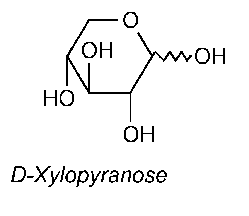Xylose
»Xylose contains not less than 98.0percent and not more than 102.0percent of C5H10O5,calculated on the dried basis.
Packaging and storage—
Preserve in tight containers at controlled room temperature.
Color of solution—
Afreshly prepared solution (1in 10)is clear and colorless.
Identification—
A:
Solvent system—Mix 60mLof butyl alcohol with 40mLof pyridine and 30mLof water.
Standard preparation—
Prepare a solution of USP Xylose RSin water to obtain a solution having a concentration of 100mg per mL.
Test preparation—
Dissolve 1g of Xylose in water,and add water to make 10mL.
Spray reagent—
Dissolve 1.66g of phthalic acid and 0.93g of freshly distilled aniline in 100mLof water-saturated butyl alcohol.The solution may be stored in a brown glass bottle in a cold place,but is to be discarded if darkening becomes marked.
Chromatographic sheet—
Use filter paper (Whatman No.1or equivalent).Draw a spotting line 6cm from one edge of the sheet.
Procedure—
Line a suitable chromatographic chamber,prepared for descending chromatography (see Chromatography á621ñ),with blotting paper.Fill the solvent trough with Solvent system,and place a sufficient amount of Solvent systemin the bottom of the chamber to permit the lining to be in contact with it.Allow the chamber to equilibrate for not less than 16hours.To the spotting line apply 2µLof the Standard preparationstepwise so that the spot is not more than 3mm in diameter.Similarly apply 2µLof the Test preparationto the spotting line and 4cm from the Standard preparationspot.Expose the sheet to the atmosphere of the Solvent systemin the closed chamber for 4hours,then dip the edge of the sheet into the Solvent systemin the trough,and develop until the liquid front has reached about 2.5cm from the end of the sheet.Remove the sheet from the chamber,dry it with the aid of a gentle current of air,apply the Spray reagent,and dry the sheet at 105 to 110
to 110 for 5to 10minutes.If the spots are faint,respray and redry,and if necessary view under UVlight:the RFvalue of the spot from the Test preparationcorresponds to that from the Standard preparation.
for 5to 10minutes.If the spots are faint,respray and redry,and if necessary view under UVlight:the RFvalue of the spot from the Test preparationcorresponds to that from the Standard preparation.
B:
Standard preparation—Transfer 10mg of USP Xylose RSto a suitable vial,and add 1mLof pyridine,0.2mLof hexamethyldisilazane,and 0.1mLof chlorotrimethylsilane.Cap the vial,shake vigorously for 30seconds,and allow to stand for 5minutes.
Test preparation—
Using 10mg of Xylose,proceed as directed under Standard preparation.
Procedure—
Use a gas chromatograph equipped with a flame-ionization detector and a 3-mm ×1.8-m stainless steel column packed with 10%phase G2on support S1A.Under typical conditions,nitrogen being used as the carrier gas,the column temperature is operated at 170 ,and the injector block and detector temperatures at 300
,and the injector block and detector temperatures at 300 .Inject 0.5µLeach of the Test preparationand the Standard preparation:the retention times correspond.
.Inject 0.5µLeach of the Test preparationand the Standard preparation:the retention times correspond.
Specific rotation á781Sñ:
between +18.2 and +19.4
and +19.4 .
.
Test solution:
100mg per mL,in 0.012Nammonium hydroxide.
Loss on drying á731ñ—
Dry 2g to 5g at a pressure not exceeding 50mm of mercury at 60 to constant weight,a current of dried air being passed through the oven during the drying period to remove water vapor:it loses not more than 0.1%of its weight.
to constant weight,a current of dried air being passed through the oven during the drying period to remove water vapor:it loses not more than 0.1%of its weight.
Residue on ignition á281ñ:
not more than 0.05%.
Iron á241ñ—
Dissolve 2.0g in 45mLof water,and add 2mLof hydrochloric acid:the limit is 5ppm.
Heavy metals á231ñ—
Dissolve 2.0g in water to make 25mLof solution:the limit is 0.001%.
Chromatographic purity—
The paper chromatogram of the Test preparationin Identificationtest Ashows no foreign spot greater than any foreign spot from the Standard preparation,and the gas chromatogram of the Test preparationin Identificationtest Bshows no foreign peak greater than any foreign peak from the Standard preparation.
Organic volatile impurities,Method Iá467ñ:
meets the requirements.
Assay—
p-Bromoaniline solution—
Dissolve 2g of p-bromoaniline in 100mLof thiourea-saturated glacial acetic acid.Store in an amber glass bottle,and prepare weekly.
Standard preparation—
Dissolve a suitable quantity of USP Xylose RS,accurately weighed,in saturated benzoic acid solution to obtain a solution having a known concentration of about 100µg per mL.
Assay preparation—
Dissolve about 1000mg of Xylose,accurately weighed,in saturated benzoic acid solution in a 100-mLvolumetric flask,and dilute with saturated benzoic acid solution to volume.Pipet 1mLof this solution into a second 100-mLvolumetric flask,dilute with saturated benzoic acid solution to volume,and mix.
Procedure—
[NOTE—In this procedure,keep strict control of time between steps.]Pipet 1-mLportions of the Standard preparationinto each of two test tubes,and pipet 1-mLportions of the Assay preparationinto each of two other test tubes.Into each tube pipet 5mLof p-Bromoaniline solution,and mix.Loosely stopper one tube from each pair,place in a water bath at 70 for 10minutes,remove,cool rapidly to room temperature,and mix.Set the tubes in the dark for 70minutes.Concomitantly determine the absorbances of the treated solutions at the wavelength of maximum absorbance at 520nm,with a suitable spectrophotometer,using the respective untreated solutions as blanks.Calculate the quantity,in mg,of C5H10O5in the portion of Xylose taken by the formula:
for 10minutes,remove,cool rapidly to room temperature,and mix.Set the tubes in the dark for 70minutes.Concomitantly determine the absorbances of the treated solutions at the wavelength of maximum absorbance at 520nm,with a suitable spectrophotometer,using the respective untreated solutions as blanks.Calculate the quantity,in mg,of C5H10O5in the portion of Xylose taken by the formula:
10C(AU/AS),
in which Cis the concentration,in µg per mL,of USP Xylose RSin the Standard preparation;and AUand ASare the absorbances of the solutions from the Assay preparationand the Standard preparation,respectively.
Auxiliary Information—
Staff Liaison:Ravi Ravichandran,Ph.D.,Senior Scientist
Expert Committee:(EMC)Excipients:Monograph Content
USP28–NF23Page 2042
Phone Number:1-301-816-8330
